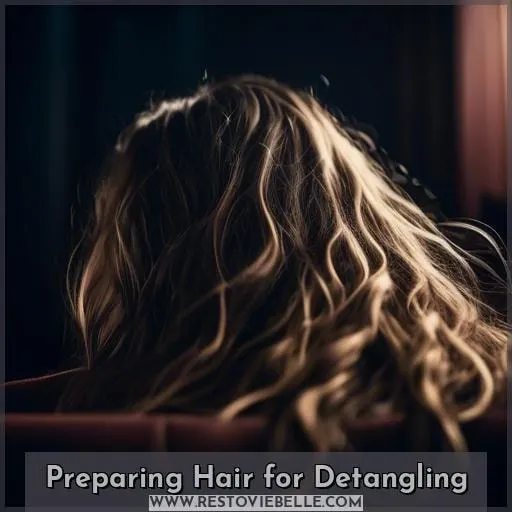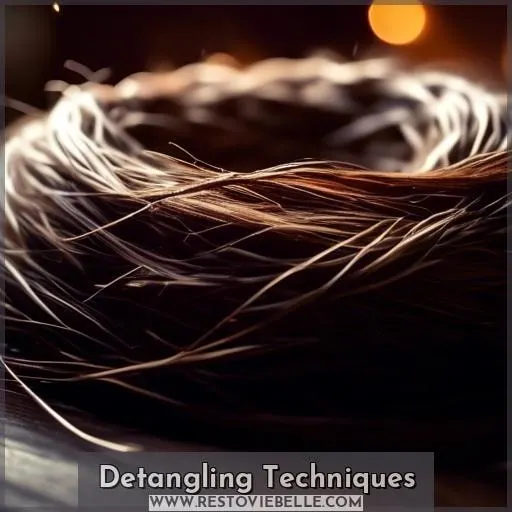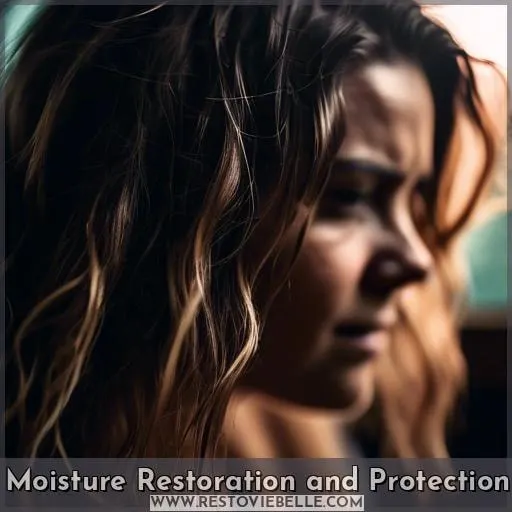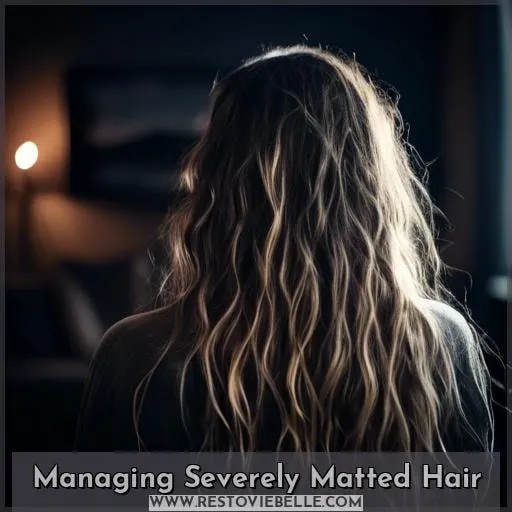This site is supported by our readers. We may earn a commission, at no cost to you, if you purchase through links.

Hospital stays, while crucial for health, can leave you with severely matted hair, a knotty challenge that seems insurmountable.
Fear not, for this guide is your ally in reclaiming your hair’s glory. You’ll learn to gently unravel the snarls and restore your locks to their pre-hospital luster.
Let’s embark on this detangling quest together, transforming what seems like a hair nightmare into a manageable journey.
Table Of Contents
- Key Takeaways
- Gathering Supplies
- Preparing Hair for Detangling
- Detangling Techniques
- Moisture Restoration and Protection
- Managing Severely Matted Hair
- Preventing Future Matting
- Frequently Asked Questions (FAQs)
- How can I protect my scalp from discomfort during the detangling process of severely matted hair?
- Are there any specific dietary considerations that can help improve the condition of matted hair?
- What are the risks of using home remedies like mayonnaise or oils on colored or chemically treated hair when detangling?
- How can I safely detangle matted hair if I have a sensitive scalp or skin conditions like psoriasis or eczema?
- Can certain hairstyles or haircuts help prevent the recurrence of severe matting after it has been successfully detangled?
- Conclusion
Key Takeaways
- Professional detangling services can be considered for severely matted hair, especially if the individual is unable to manage the detangling process on their own.
- Using scissors to cut the hair should be a last resort after attempting to detangle with fingers and a wide-tooth comb.
- It is important to assess the severity of matting before beginning the detangling process, and consulting a hair stylist is advisable if the matting is too tight.
- Preventative measures such as regular scalp stimulation, trimming, moisturizing, and protective styling can help avoid future matting.
Gathering Supplies
When dealing with severely matted hair after a hospital stay, it’s crucial to gather the right supplies for a successful detangling process.
- A spray bottle
- Wide-tooth and rat-tail combs
- A slippery detangler
- Clips or elastics for sectioning
These tools are indispensable for gently and effectively working through mats without causing further damage to your hair. Additionally, choosing the right detanglers and conditioners is vital for softening the hair and making the detangling process as painless as possible.
Essential Tools for Detangling
- Detangling Sprays: These are your first line of defense. A good detangling spray can make a world of difference, acting like a magic potion that eases the comb through your hair.
- Wide-Tooth Comb: This tool is your best friend. It’s like a gentle giant that carefully works through the tangles without pulling too hard on your hair.
- Hair Detangler Brush: For those stubborn knots, a hair detangler brush can be a lifesaver. It’s like having a fairy godmother for your hair, making tangles disappear with a flick of the wrist.
Choosing Detanglers and Conditioners
When choosing detanglers and conditioners, you’re looking for that magic potion to turn your hair from a bird’s nest into silky strands. You’ll want to eye up products that are as slippery as an eel in a bucket of snot—those with ingredients that’ll make your comb glide through like a hot knife through butter.
Vegan options are the cherry on top for our animal-loving hearts, and if your hair’s been kissed by color, make sure it’s safe for color-treated hair.
| Detangling Product | Key Ingredients | Special Features |
|---|---|---|
| Detangling Oil | Jojoba, Vitamin E | Deeply moisturizes |
| Detangling Conditioner | Panthenol, Herbal Extracts | Smooths cuticle |
| Detangling Deep Conditioner | Proteins, Natural Oils | Restores moisture overnight |
| Vegan Conditioning Options | Plant-based Extracts | Cruelty-free, no animal byproducts |
Preparing Hair for Detangling
When preparing hair for detangling, especially after a hospital stay where hair may have become severely matted, it’s crucial to start with the right approach.
Wet your hair thoroughly to make it more pliable and apply a slippery detangler generously. This initial step softens the hair and prepares it for a less painful and more effective detangling process.
Next, sectioning your hair into manageable parts, typically four, helps in organizing the detangling task, making it easier to focus on smaller areas at a time and ensuring the detangler is evenly distributed throughout your hair.
This methodical approach not only aids in minimizing breakage but also in making the detangling process more manageable and less overwhelming.
Wetting and Applying Detangler
After you’ve gathered your detangling arsenal, it’s time to prep your locks for the untangling battle.
First things first, drench your hair with water to ease the upcoming skirmish with those knots. Grab that slippery detangler and slather it on generously; think of it as your hair’s suit of armor.
While you wait, section your hair into manageable quadrants to avoid a free-for-all tangle fest. Remember, protecting your roots while you work is like guarding your castle’s gates; it’s essential for keeping the peace.
Sectioning Hair
After you’ve wet your hair and applied a slippery detangler, it’s time to tackle the next step: sectioning your hair. This is where you’ll start to see the light at the end of the tunnel, as organizing your hair into sections is like mapping out a path through a tangled forest.
- Parting hair: Use a rat tail comb to create clean parts, making your task as neat as a pin.
- Detangling sections: Work on one section at a time to avoid feeling like you’re wrestling an octopus.
- Using clips: Secure each section with clips or a cotton t-shirt to keep them out of the way, like a shepherd corralling sheep.
- Detangling layers: Approach each section layer by layer, as if you’re peeling back the layers of an onion, but hopefully with fewer tears.
Detangling Techniques
You’ll need to gently work through tangles using your fingers before reaching for a comb.
Choosing the right comb is crucial; a wide-tooth comb is best for minimizing breakage and pain.
Finger Detangling
After prepping your hair with a slippery detangler, it’s time to get hands-on with finger detangling.
This technique is all about using your fingertips to gently tease apart those matted areas. Think of your fingers as a nimble team of detanglers, each one working with finesse to untangle the knots without the snap, crackle, and pop of breakage.
Your finger dexterity allows for a gentle approach, ensuring you maintain hair health while working through the tangles.
So, take your time, and let your fingers dance through your locks, turning a tangled mess into detangled success.
Comb Selection and Use
After you’ve started the detangling process with your fingers, it’s time to bring in the right tools for the job. Choosing the right comb is crucial to avoid further damage and to make the process as pain-free as possible.
- Wide-tooth combs are your best friend when it comes to detangling. They glide through your hair, teasing out knots without tugging too hard.
- Detangling brushes are designed to minimize breakage, with flexible bristles that can help work through tough spots.
- Metal combs with smooth, rounded tips, like the rat tail comb, can be helpful for finer work, such as parting hair or teasing out smaller knots.
Moisture Restoration and Protection
Restoring moisture to your hair after a hospital stay is crucial for tackling severe matting.
Deep conditioning treatments and oil applications can significantly improve hair manageability and health.
Deep Conditioning
After you’ve tackled the initial detangling with patience and a gentle touch, it’s time to lavish your locks with some deep conditioning love. Think of it as a spa day for your strands, a chance to infuse moisture back into your hair and say goodbye to those pesky hair mats and tangles.
Go ahead, slather on that deep conditioner like you’re icing a cake—your hair deserves it. Or, if you’re feeling adventurous, why not whip up an overnight mask? Mix in some shea butter for good measure, and let your hair soak up the goodness while you catch some Z’s.
If you’re dealing with severely matted hair after a hospital stay, consider a hot oil treatment or hair steaming to really get the moisture deep into those tresses.
Oil Treatments
Dive into the world of oil treatments for a hair revival like no other. Imagine Moroccan argan oil as your knight in shining armor, battling dryness and fortifying each strand. For deep moisturizing, let oils soak in overnight, transforming your mane by morning.
This isn’t just about avoiding hair knots; it’s about empowering your hair to withstand heating, chemical treatments, and even hair extensions.
Managing Severely Matted Hair
If you’re dealing with severely matted hair after a hospital stay, seeking professional detangling services can be a wise choice.
Professional Detangling Services
When you’re fresh out of a hospital stay, the last thing you want is the added stress of tackling severely matted hair. If you’re dreading the thought of sorting out the tangles yourself, it’s worth considering professional detangling services.
Salons understand the delicate nature of post-hospital hair and can offer a gentle touch to avoid further hair breakage. Before you book, do a quick salon availability check and cost comparison—some places might be overbooked, and prices can vary.
Remember, time commitment is a factor; you might need to block out a good chunk of your day.
When scheduling your appointment, be upfront about the state of your hair; honesty helps your stylist prepare.
When to Use Scissors
When faced with severely matted hair after a hospital stay, reaching for scissors might seem like the quickest solution, but it’s not always necessary.
- Assess the severity of the matting. If you can loosen the knots using a detangler and patience, scissors can be avoided.
- Try detangling with your fingers first, then move on to a wide-tooth comb, starting from the ends and working your way up to minimize breakage.
- If the matting is too tight and causing scalp irritation, consult a hair stylist before cutting to ensure hair health is maintained.
- Use scissors as a last resort, and only if the knots are impossible to remove without causing significant hair damage or pain.
Preventing Future Matting
To prevent future matting, it’s crucial to establish a regular care routine that includes gentle detangling and moisturizing.
Opting for protective styles can also safeguard your hair from tangles and breakage.
Routine Care and Maintenance
After conquering the tangle jungle, it’s time to keep your mane on the straight and narrow. Regular scalp stimulation and trims ward off split ends and encourage hair growth.
| Routine Action | Benefit | Frequency |
|---|---|---|
| Scalp Massage | Stimulates hair growth | Weekly |
| Trimming | Prevents split ends | Monthly |
| Moisturizing | Maintains scalp health | Daily |
Stick to this, and you’ll be the mane attraction!
Protective Styling
To keep your hair game strong and avoid future matting, let’s talk protective styling. Think of it as your hair’s personal bodyguard, shielding those precious strands from the rough and tumble of daily life.
But here’s the kicker: overdoing it can backfire, leading to scalp irritation and stunting hair growth.
Keep your arsenal of products in tip-top shape—product storage is key to maintaining their effectiveness. And when it comes to heat damage, steer clear like it’s a bad hair day waiting to happen.
If you’re feeling crafty, whip up some DIY remedies to pamper your scalp and hair.
Frequently Asked Questions (FAQs)
How can I protect my scalp from discomfort during the detangling process of severely matted hair?
To shield your scalp from discomfort while detangling severely matted hair, apply a leave-in detangler generously.
This creates a slippery surface, easing comb-through and reducing pull on your scalp and roots.
Are there any specific dietary considerations that can help improve the condition of matted hair?
Imagine your hair as a garden; what you feed it will bloom into health.
Incorporate foods rich in omega-3s, proteins, vitamins A, C, D, E, iron, and zinc to nourish your hair from within.
What are the risks of using home remedies like mayonnaise or oils on colored or chemically treated hair when detangling?
Using home remedies like mayonnaise or oils on colored or chemically treated hair can lead to unexpected reactions.
How can I safely detangle matted hair if I have a sensitive scalp or skin conditions like psoriasis or eczema?
For those with sensitive scalps or conditions like psoriasis or eczema, gently detangle matted hair using products formulated for sensitive skin. Avoid harsh chemicals. Opt for natural, soothing ingredients and be gentle to prevent irritation.
Can certain hairstyles or haircuts help prevent the recurrence of severe matting after it has been successfully detangled?
Imagine this: you’ve just conquered the beast of matted hair, and you’re looking to keep the tangles at bay.
Think low-maintenance ‘dos like braids or twists, which not only keep your hair organized but also reduce manipulation and friction that can lead to matting. Protective styles like these are a godsend, especially if you’re someone who’s not up for daily styling battles.
Just remember, while these styles are like a cozy blanket for your hair, don’t leave them in too long, or they might get too comfortable and cause a different kind of tangle trouble.
Conclusion
Imagine the sun breaking through the clouds after a storm, illuminating a path forward. This is akin to the journey you’ve embarked on to detangle severely matted hair after a hospital stay.
With the right tools, techniques, and care, what seemed like an insurmountable challenge becomes a testament to your resilience and dedication.
By following the steps outlined, you’re not just restoring your hair’s health and beauty; you’re reclaiming a piece of yourself that was lost in the shuffle of medical recovery. Let this guide be a beacon, leading you back to a state of normalcy and confidence.
Your hair’s revival is more than just cosmetic—it’s a symbol of your strength and ability to overcome the odds.












